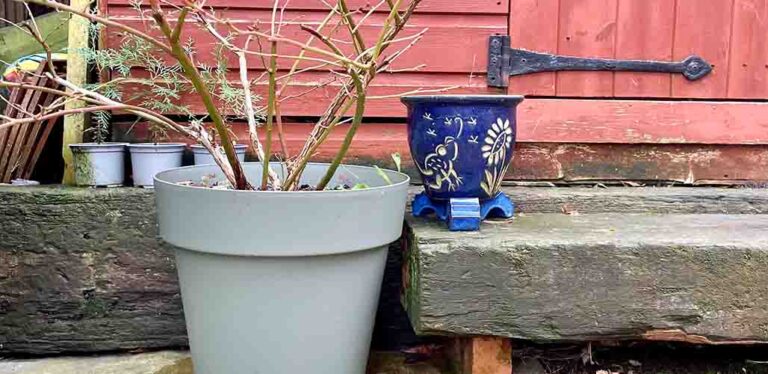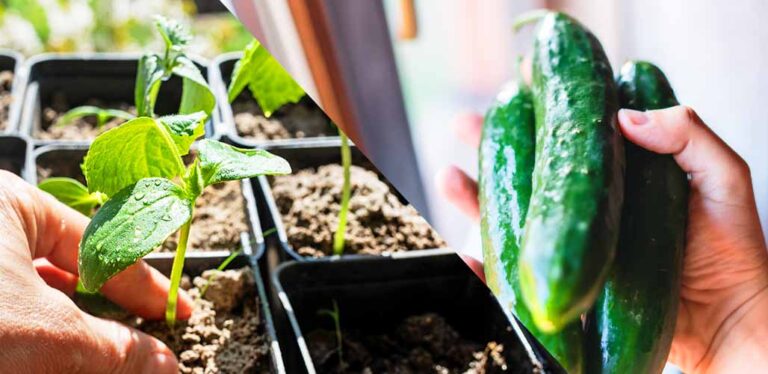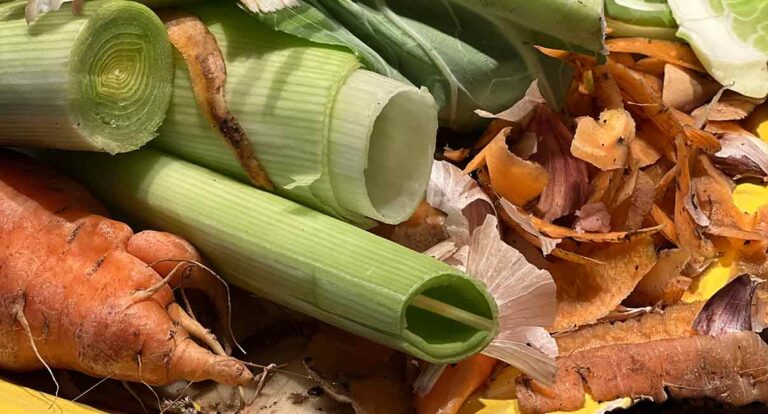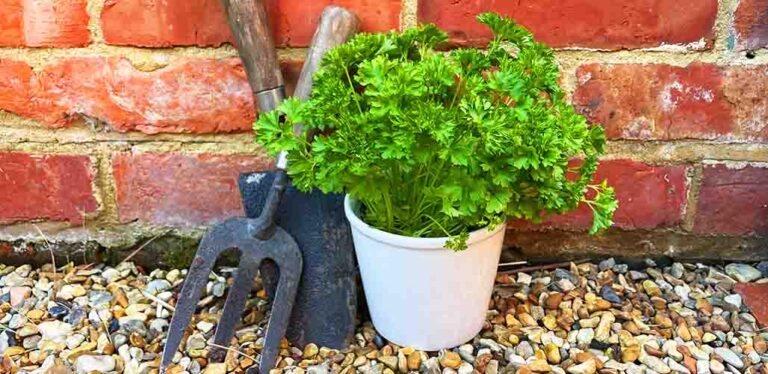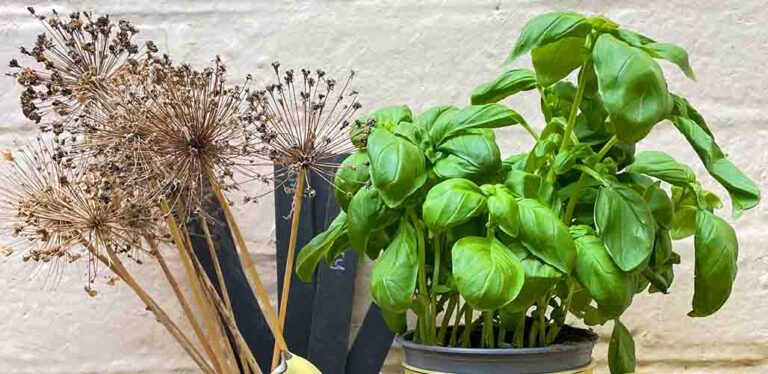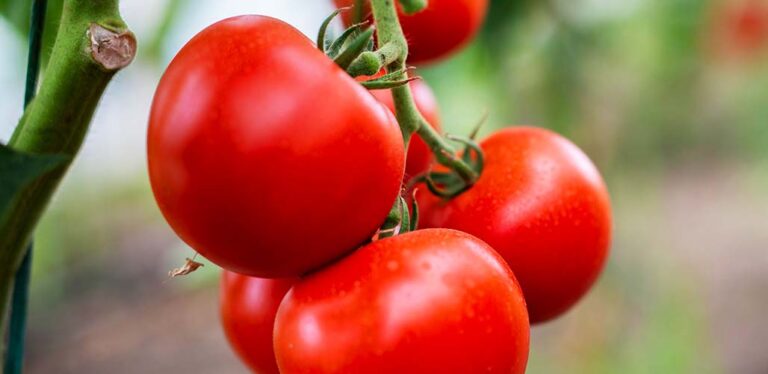Shrubs That Love Acid Soil And Tips For Helping Them Thrive
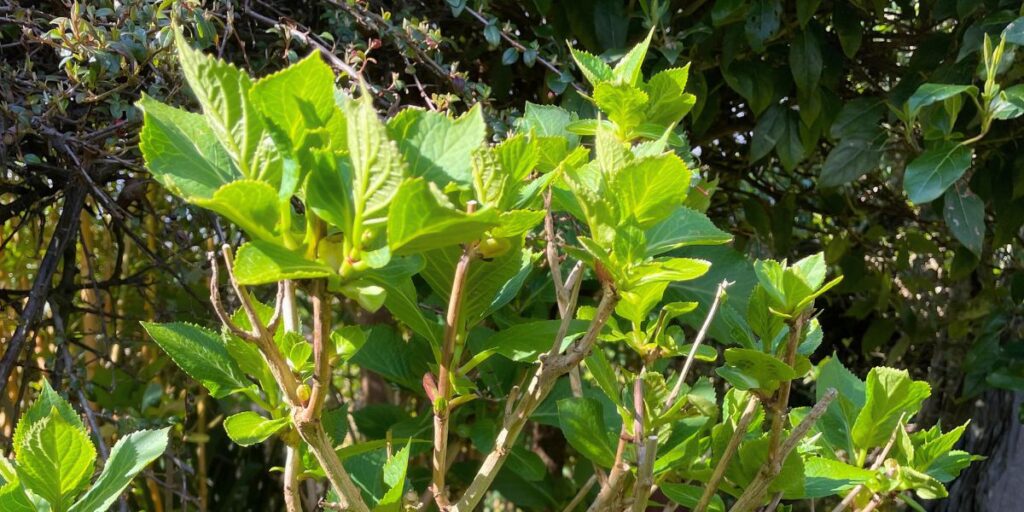
Shrubs are usually among the largest plants in our yards and gardens, but it’s still easy to underestimate their potential for adding privacy, structure and beauty to an outdoor space. In fact, the shrubs you choose and where you plant them can make or break a backyard. No one wants a sad and straggly specimen grabbing all the attention! Soil acidity is one variable that determines whether a plant will thrive or wither in its location. So if you’re one of the many gardeners gardening on acid soil, here are some shrubs which will love your yard.
- What causes acid soil?
- How does acid soil affect shrubs?
- Shrubs which only thrive in acid soil
- Shrubs which grow happily in more than one soil type, including acid soil
- Caring for your shrubs on acid soil
What causes acid soil?
Acid soils are also known as ericaceous soils. The term ericaceous comes from the Latin family name for heathers – Ericaceae – which also grow best in acid soil. Soil acidity and alkalinity are measured using the pH scale, where 0 is as acidic as it’s possible to be, and 14 is as alkaline as it is possible to be. A pH value of 7 is neutral – neither acidic nor alkaline.
Most soils are pH neutral, or fractionally acidic. When organic matter decomposes, it creates acidic conditions – and pretty much all soils sometimes contain something that’s decomposing, even if it’s just last year’s dead leaves. There’s no definitive threshold below which acidic soil qualifies as ericaceous, but a commonly used rule of thumb is that soils with a pH below 6.5 are definitely acidic. Soil pH below 5.5 is very acidic or ericaceous, and soil acidity can even get as low as 3.5 – but such conditions are very rare indeed.
Acidic soils are usually found on top of granite bedrock. Soil acidity is increased by:
- Organic matter decaying in the soil
- Acidic ‘parent material’ in the soil – such as leaf fall from oak trees and pine trees
- Heavy rainfall
- Intensive cultivation for crops
- Over application of fertilizers
If you’re not sure what the pH of your soil is, testing kits are readily available from garden centers and online. It’s a good idea to test the soil in several locations around your yard – pH can be remarkably variable, even within a small area!
How does acid soil affect shrubs?
The good news is most plants enjoy growing in slightly acidic soils. Since slightly acidic conditions are so widespread, many plants have adapted over time to make the most of them. Soil acidity also makes some nutrients in the soil more readily available for plants’ roots to absorb. But strongly acidic soils can also make nutrients inaccessible to plants, and make trace quantities of toxic elements like aluminum more damaging than they would be in pH neutral soil. Soils that are made acidic by heavy rainfall might also become nutrient poor because the nutrients are getting washed out.
Choosing shrubs for acidic soil
If you’re gardening on acidic soil, choosing ericaceous-loving shrubs is a sensible investment. They’re far more likely to grow well and perform reliably in terms of flowers or bright autumn foliage. But acidity tolerance isn’t the only thing to consider when choosing shrubs. The plants in this list all tolerate or prefer ericaceous soil, but have different levels of resilience when it comes to:
- Growing in shade
- Wind exposure
- Drought
- Waterlogging
- Extremes of temperature
You also need to consider whether their mature size is right for your space, how much of the year they will provide visual interest for, and whether they need much maintenance (such as pruning or protecting from frost).
Shrubs that only grow happily in acidic soil
These plants don’t just love acidic soil – they only grow happily in acidic soil.
Rhododendrons
If you can only name one plant you’re already aware of that loves acidic soil, I’d make a small bet it’s the rhododendron. These shrubs can be small enough for a container in a courtyard garden or tall enough to dwarf a house, but they always put on a flamboyant show of flowers in late spring.
Historically, they do have a reputation for being fussy. Ericaceous soil wasn’t enough – you also needed lots of rainfall, moderate humidity, mild winters and summers that weren’t too hot, and a sheltered spot where they wouldn’t get blown about by high winds. But modern plant breeding has produced some much more resilient varieties, and it’s worth visiting a knowledgeable local plant nursery to find out which ones could live happily with you.
Azaleas
Azaleas are closely related to rhododendrons, but rhododendrons are usually evergreen, and azaleas are usually deciduous. Most azaleas are small or medium sized shrubs too, so if your yard is small, an azalea is less likely to outgrow its space. Some gardeners also find that azaleas are more adaptable and forgiving of less-than-perfect conditions than rhododendrons. So if you’ve already tried and failed with rhododendrons, you might have more luck with azaleas.
Fun fact: The definitive way to tell an azalea from a rhododendron is to count the stamens (the pollen-bearing stalks) inside each flower. Rhododendrons have 10, and azaleas have 5.
Chilean lantern trees
Despite their name, Chilean lantern trees (Crinodendron hookerianum) also make happy shrubs. The only difference is whether they have several branches growing from the base of the plant (a shrub), or one single one (a tree).
Chilean lantern trees are evergreen, and for several weeks in spring and summer they produce beautiful deep pink flowers that look like hundreds of delicate paper lanterns. Lantern trees need acid soil and some shade if you live in a particularly hot region. If you live in an especially cold region, they might need a little frost protection in winter as well. But despite their demands, if you’re planting a shrub in a prominent position and you want it to be something special, this one is definitely worth the effort.
Magnolia
I love magnolias. One of the happiest gardening days of my life was finally having a yard big enough to plant one of my own (if only I’d known earlier about the dinky Magnolia stellata, which was compact enough to grow in a container all along). Like lantern trees, magnolias can be grown as a tree, or a large shrub. Magnolia flowers come in creams, yellows, every shade of pink, and even deep purples. Best of all for a lazy gardener, they don’t grow very quickly, and actively dislike being pruned. So you can plant one, then simply leave it alone and admire it.
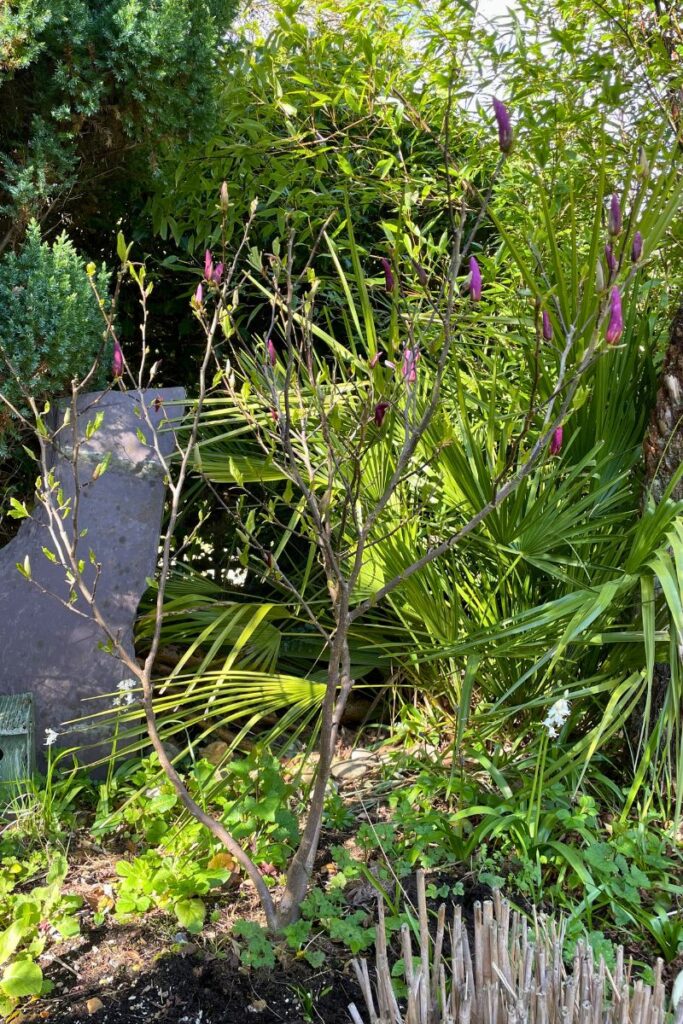
Blueberries
If you though blueberry shrubs (Vaccinium corymbosum) were just about berries, think again! They can be small (about 2 feet tall) or large (over 5 feet tall). Besides their tasty berries, some varieties produce showy pink blossoms, and nearly all put on a bright display of fiery red and orange autumn foliage. So they’re a fantastic way of planting a border with shrubs that are productive, as well as ornamental.
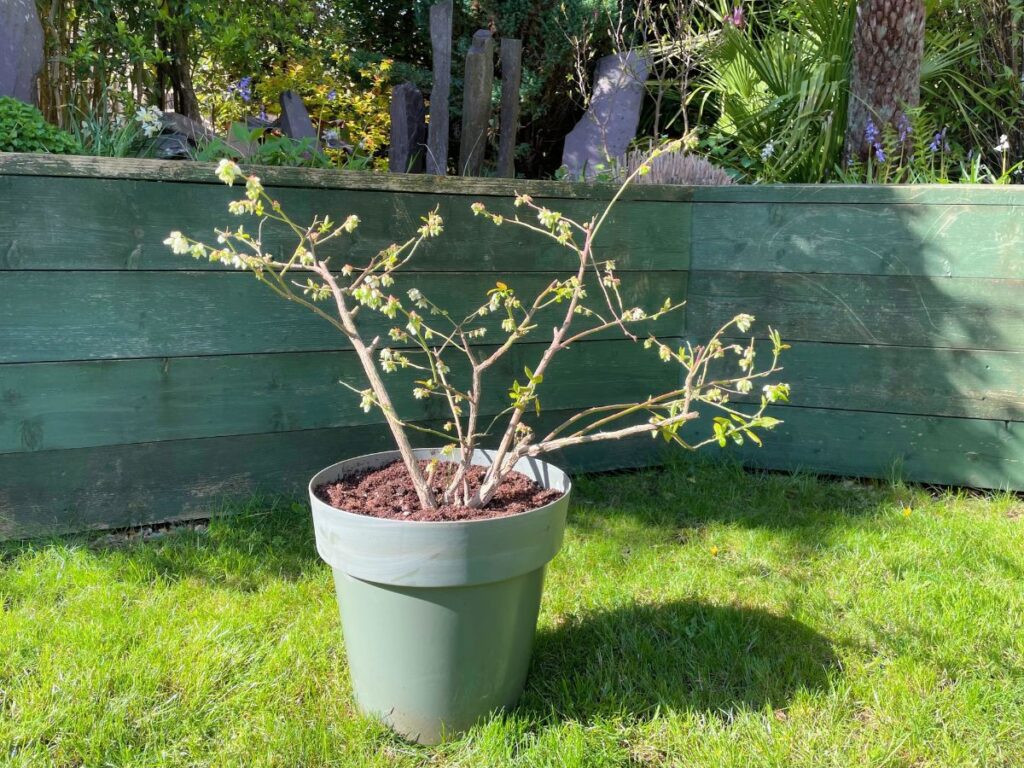
Shrubs which can grow in several soil types, including acidic soil
These next shrubs are adaptable when it comes to soil acidity. They will grow in many soil types, including ericaceous soils.
Hydrangeas
Hydrangeas can be shrubs or climbers, and if it’s a shrub you’re looking for, you want one with one of these names on the label:
- Hydrangea macrophylla (a.k.a. mophead or bigleaf hydrangeas)
- Hydrangea serrata (a.k.a. mountain hydrangeas)
- Hydrangea arborescens (a.k.a. smooth hydrangeas)
- Hydrangea quercifolia (a.k.a. oak leaf hydrangeas)
- Hydrangea paniculata (a.k.a. panicle hydrangeas)
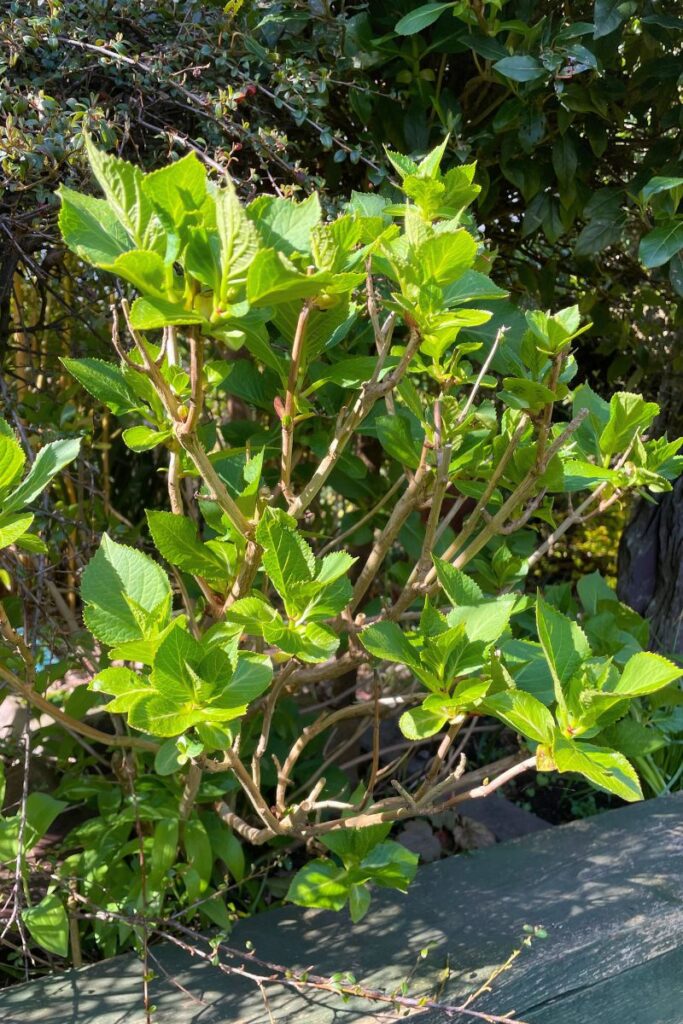
Depending on your space, you can find hydrangeas barely more than 1 foot tall, or varieties which slowly grow to 8 feet tall. Most of them need thoughtful pruning in early spring, with the easy-maintenance exception of panicle and smooth hydrangeas, which can simply be chopped back to 6 inches tall all over. The flowers are fantastic for cutting and drying, and the most exciting thing about growing hydrangeas in acidic soil is that you’ll get blue flowers instead of pink!
Holly
Common or English holly (Ilex aquifolium) is a glossy, spiky, and surprisingly helpful plant, even if it does require two pairs of ultra-thick gardening gloves to prune them safely! It grows in all kinds of conditions, but it’s especially happy in acidic soils and full sun or dappled shade. As well as the quintessential solid-green leaved holly, look out for cultivars with white or yellow margins. If you’d like to experiment with a bit of topiary and turn your shrub into a work of art, you could even choose holly’s tiny-leaved cousin, Japanese holly (Ilex crenata).
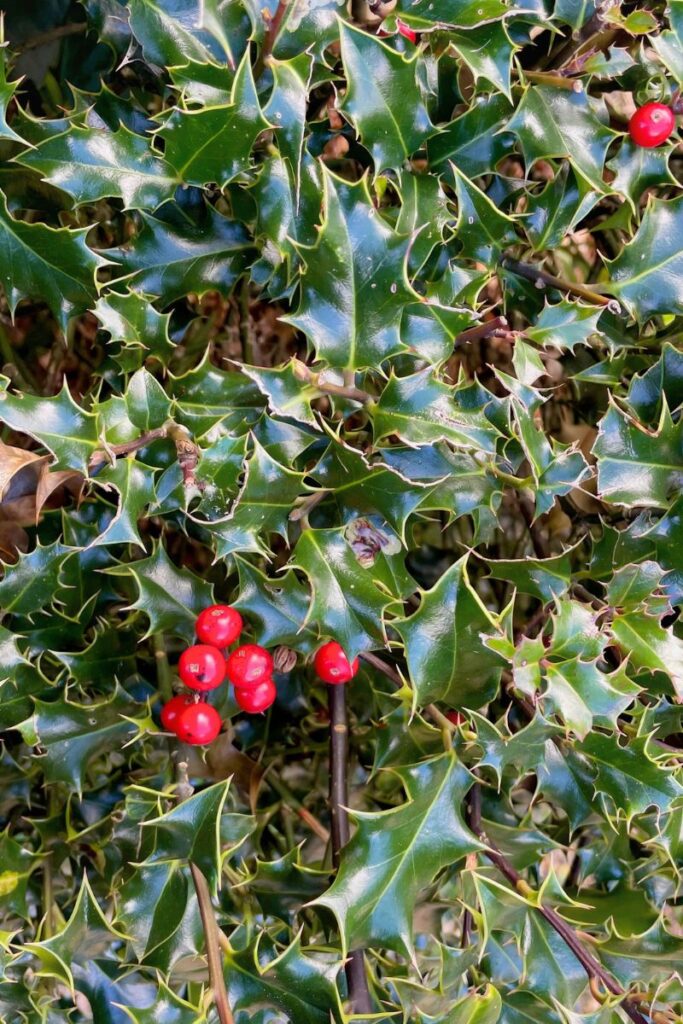
Here are three more facts in praise of the common holly bush:
- The berries provide a valuable food source for birds.
- The stems last for ages after being cut so you can make glorious wreaths and garlands for free at Christmas.
- And the dead leaves that collect underneath them are like kryptonite to slugs and snails. Collect them with leaf scoops and lay them thickly around the base of your hostas or squashes instead!
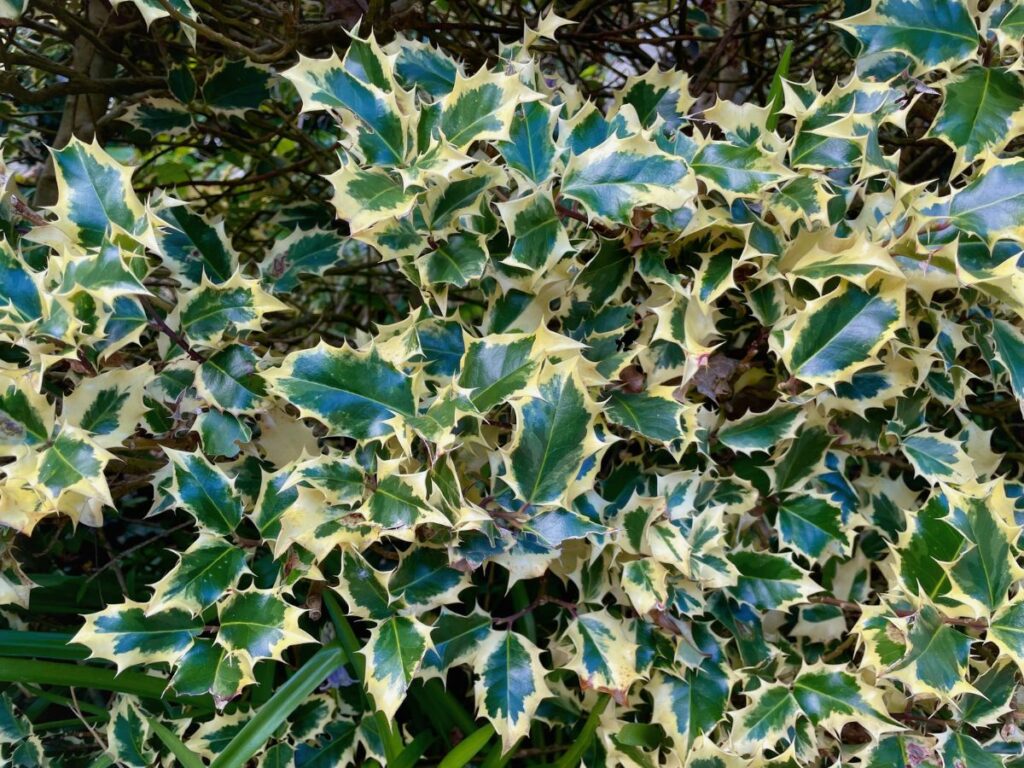
Bottlebrush
Since acidic soils are often brought about by high rainfall, it’s hardly a surprise that many of the plants adapted to thrive in acid soils also prefer overcast or lightly shaded conditions. But here’s one shrub that loves ericaceous soils and baking hot sun. Bottlebrush shrubs (Callistemon citrinus) are evergreen and drought resistant. They get their name from their cylindrical red flowers, which bloom in spring and summer and do indeed resemble bottle brushes. If you’d like something a little bit unusual, look out for lemon bottlebrush (Callistemon pallida), which has white flowers. Plant your bottlebrush shrub in the sunniest spot in your garden, making sure you leave plenty of space for it to grow – it will eventually reach at least 12’ tall.
Viburnums
Viburnums are a large family of shrubs which produce clusters of tiny, strongly perfumed flowers in early spring. They’re an asset in any busy person’s low maintenance garden because they’re really just pretty easy to grow. Many varieties are evergreen, and sport dense foliage that’s ideal for hiding whatever they’re planted in front of. This Viburnum tinus does a superb job hiding an ugly section of concrete fence in our yard, and didn’t mind being planted in an unfavorable spot between a fence and the base of two well-established trees. In fact it’s grown so vigorously in the last three years that I may need to start pruning it this winter!
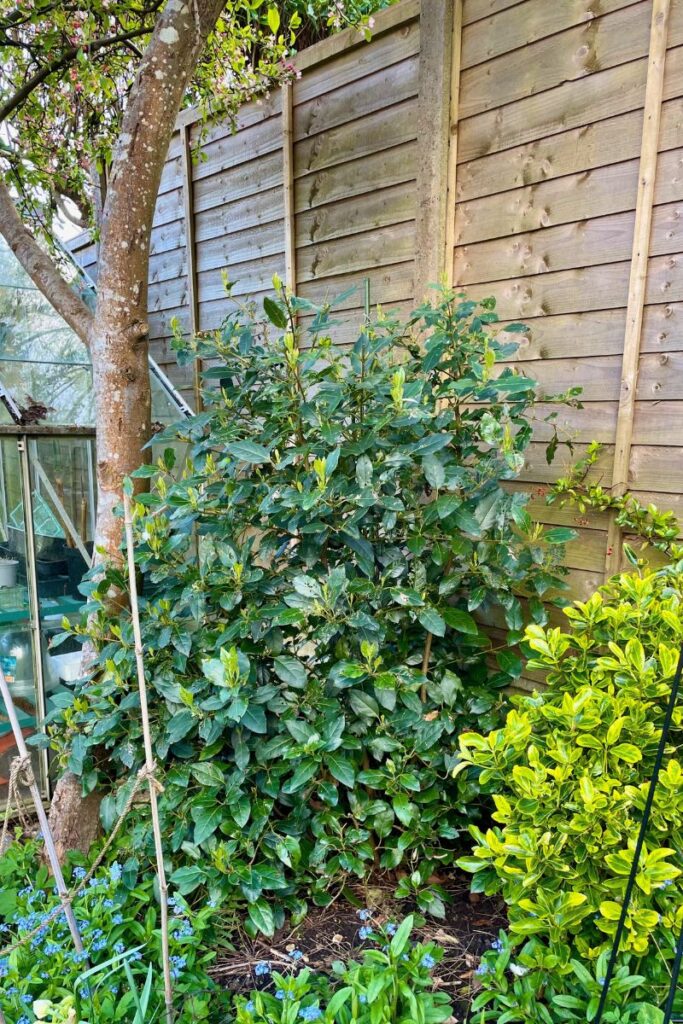
Spindles
Spindles (Euonymous spp) are among the shrubs my mom somewhat ungenerously tends to refer to as ‘municipal planting’. Meaning they’re a bit boring, and tend to put you in mind of urban parks. But they’re also practically foolproof to grow and very low maintenance. They’re evergreen, and your kids could kick a soccer ball into one a thousand times and it would still bounce right back.
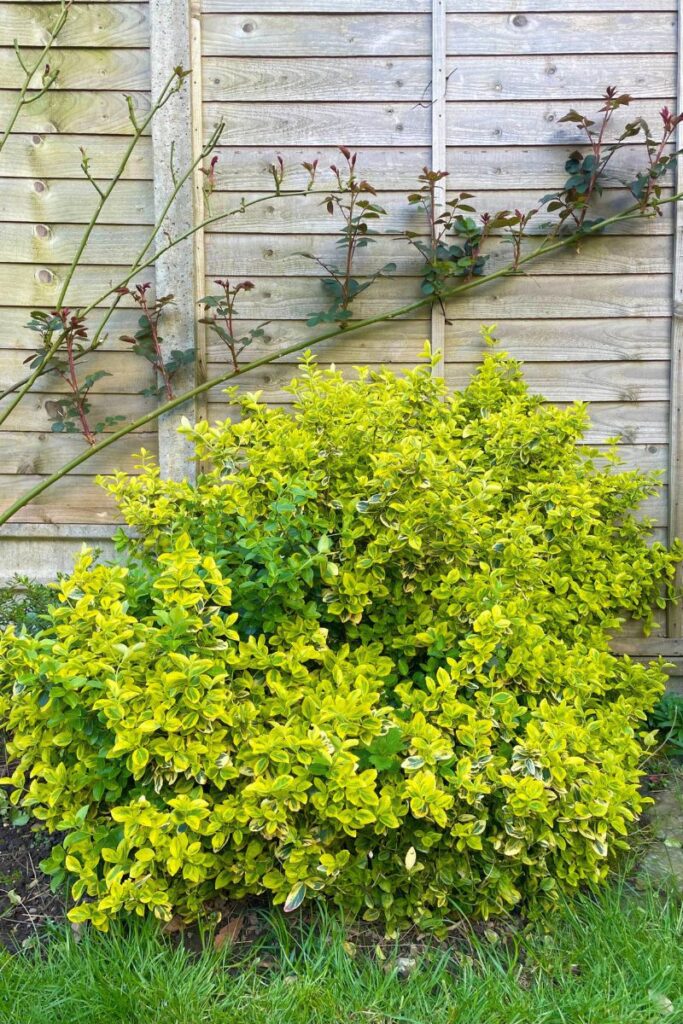
My top tips to keep your spindle shrub looking naturalistic and charming rather than ugly and unlovable are:
- Choose one of the many variegated types, such as Moonshadow, Silver King, Gold Splash, or Purple Wintercreeper.
- If they start to outgrow their space, prune them with secateurs and follow the rule of thirds – cut ⅓ of the stems right out, as close to the base of the plant as possible, and cut everything else back by ⅓ of its height. This promotes new growth from the base of the shrub, so it doesn’t end up ‘hollow’.
Gardenia
Gardenia (Gardenia spp. are just about one of the most glamorous shrubs you can grow on acidic and neutral soils. They have dark green, glossy leaves, and large white flowers with a strong perfume that’s both floral and fruity. They are relatively compact shrubs, only reaching about 3’ or 4’ tall. They’re also frost tender, so take advantage of their small size and grown them in a container, so that you can more easily protect them from sub-zero temperatures in winter.
Tips for growing shrubs that love acid soil
Most acid loving plants also like rich, high nutrient soils. Which makes sense, because acid conditions are frequently the result of lots of decomposing organic matter. If you’re planting your shrub in a corner with poor soil – perhaps because lots of the nutrients have already been removed by a plant which grew there before – dig plenty of compost or well-rotted manure into the ground first.
Not many acid loving plants are known for being drought-resistant, so mulch around their base thickly in spring to conserve moisture around their roots. Bagged ericaceous composts, pine needles, and leaf mold are all good mulch choices.
Shrubs that love acid soil – summary
If you have acid soil, it’s much better to choose plants that will love it for what it is, rather than trying to change the pH of your soil. Luckily, there are lots to choose from, so whether your yard is small and shaded or big and sun baked, you can have beautiful shrubs which will look beautiful and give structure to your outside space all year round. Let us know which shrubs you’ll be planting in your acidic borders using the comments box down below.

